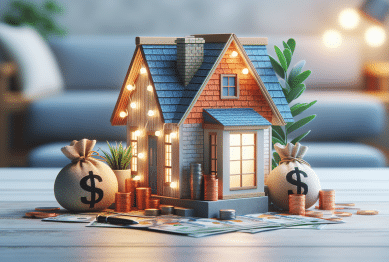Many are surprised to discover what actually shapes a property’s value. This guide explores unique real estate trends, housing market shifts, and how overlooked details—like community planning and energy features—can transform your home’s financial outlook.
Neighborhood Trends That Shift Property Worth
A home’s value is not just about the structure or interior features—what surrounds a property often creates a lasting financial impact. Neighborhood trends such as school proximity, public transit updates, and walkable amenities are becoming dominant forces in the housing market. These patterns influence both the perception of desirability and real, evidence-backed resale prices. For instance, properties close to newly upgraded parks or entertainment districts have seen sharp increases in marketability, which can result in higher listing prices and faster sales cycles. Trends also show that urban renewal projects often raise the profile of entire neighborhoods, attracting buyers looking for vibrant community life and long-term potential.
Another surprising influence is the way local zoning decisions alter future value. When city officials approve new construction, mixed-use developments, or updated infrastructure, ripple effects can be felt for blocks around. Homeowners paying attention to municipal planning announcements can anticipate value shifts and make informed renovation investments. This proactive strategy—watching for new transit lines or business improvements—offers an edge in a competitive real estate landscape. Some buyers even use planning maps and city council notes as added research before making offers.
Community culture also plays a subtle role. The rise of local art districts, farmers markets, or sustainable business programs can foster a positive atmosphere that increases demand. Properties in these emerging hotspots may experience both social and financial appreciation thanks to an influx of engaged residents. These factors—sometimes overlooked by casual observers—can quietly set the stage for robust home equity growth over time (Source: https://www.huduser.gov/portal/periodicals/em/fall19/highlight2.html).
Energy Efficiency and Smart Home Features
The push toward greener living has made energy efficiency a top consideration for buyers and assessors. Upgrades like solar panels, tankless water heaters, and double-paned windows can directly impact appraisals, often yielding a favorable return on investment. Smart thermostats and LED lighting systems are increasingly standard in many listings, with their presence often highlighted in real estate marketing materials. These features not only help families reduce ongoing utility bills but also make a home stand out in competitive local markets.
Government and utility-backed incentive programs are helping drive widespread adoption of these energywise updates. In many regions, rebates or tax credits offset installation costs, potentially lowering the barrier for homeowners to embark on meaningful upgrades. Studies show a growing portion of prospective buyers are searching specifically for energy-efficient homes, especially in areas where climate-conscious living is a high priority. As public awareness heats up, agents are quick to spotlight these improvements during showings.
There’s a deeper impact, too: smart home automation unlocks both convenience and safety appeals. Security systems paired with automated lights or door locks become selling points—making homes more future-proof and tech-friendly. While these innovations may start as minor conveniences, over time they create cumulative perceived value that becomes hard to ignore on comparative market analyses (Source: https://www.energy.gov/eere/buildings/articles/benefits-energy-efficient-homes).
How Outdoor Spaces Transform Buyer Decisions
Outdoor living has moved beyond simple curb appeal. Well-designed yards, patios, and balconies create fresh functional space and can shift a buyer’s opinion in moments. Features like drought-tolerant landscaping, vegetable gardens, privacy fencing, or eco-friendly irrigation offer lasting value well beyond their upfront cost. Even modest outdoor upgrades can help properties photograph better and generate stronger initial interest on listing platforms.
Buyers are increasingly drawn to homes that support healthy, outdoor lifestyles. With many families seeking more relaxation or entertaining areas at home, an accessible patio, pool, or play equipment can make a significant difference during showings. Smart placement of outdoor lighting, comfortable seating, and themed garden beds help create inviting atmospheres that feel like secondary living rooms. This trend is visible across both urban and suburban markets, particularly as remote work allows more flexibility in homebuying criteria.
Local climate directly affects which upgrades matter most. In regions with harsh winters, covered decks or fire pits are frequently highlighted, while warm climates reward shaded pergolas and grilling stations. No matter the context, well-maintained green space signals pride of ownership and can provide measurable boosts to home value as part of a complete market strategy (Source: https://www.nar.realtor/research-and-statistics/research-reports/remodeling-impact).
The True Cost of Deferred Maintenance
Home maintenance can easily slip, but the real cost of neglect emerges during resale. Small items—like a worn roof or outdated plumbing—can discourage lenders and buyers, leading to patient negotiations that drive sale prices downward. Routine repairs and annual inspections, though sometimes overlooked, offer a strong long-term payoff. Keeping up with critical systems not only extends their lifespan but creates a track record that builds buyer trust, which is critical in high-value real estate markets.
Hidden damage is a common pitfall. A home might look solid on the surface, yet deferred problems with insulation, moisture control, or foundation work can balloon into six-figure expenses. Transparent records of recent repairs, energy audits, or HVAC tune-ups now play a role in competitive listings, providing extra confidence for cautious shoppers who want to avoid surprises after closing. Many agents recommend a pre-listing home inspection or a documented schedule of recent upgrades to maximize value perception.
Smart homeowners view maintenance not just as a chore but as a strategic asset. When preparing to sell, addressing known issues early helps control timelines and sets expectations. In especially hot markets, minor neglect can separate similar listings, making proactive stewardship a reliable way to preserve—and even enhance—a property’s equity (Source: https://www.hud.gov/program_offices/housing/sfh/ins/inspect).
Local Economic Factors and Their Ripple Effects
Wider economic patterns play a powerful part in shaping home values, sometimes in ways that surprise even long-term residents. Economic indicators such as unemployment rates, business growth, and median income reveal hidden pressures on property demand and pricing. When major employers move into or away from an area, nearby housing values can swing dramatically—sometimes long before formal market reports surface. Savvy buyers and sellers often watch news about new infrastructure projects or corporate entries to anticipate future market moves.
Taxes, public service investments, and school funding decisions have longer-term influence. Lower property taxes or increased spending on local amenities can encourage in-migration and boost demand. Even changes in public transportation routes or the introduction of new parks can spark a wave of interest among buyers who value convenience and lifestyle options. These factors are not always obvious in online listings, but their aggregate impact is reflected in yearly assessment rolls and community reputation surveys.
It’s not just about economics at the macro level. Microeconomic trends—such as the launch of farmer’s markets, tech coworking hubs, or boutique retail—add texture to a neighborhood’s profile. These localized improvements attract a new demographic and can nudge median property values upward, especially in cities investing actively in placemaking and pedestrian-friendly design (Source: https://www.urban.org/urban-wire/why-economic-development-matters-housing-market).
The Role of Housing Supply and Affordability Programs
Supply dynamics have always been a real estate bedrock. When new home construction lags or local policy restricts multi-unit housing, property values can climb quickly due to rising demand. Conversely, large housing expansions or run-down rental stock may slow appreciation. Understanding the pipeline of upcoming units, conversions, or rezoning isn’t just for investors—homeowners and first-time buyers benefit from watching these trends as part of their long-term planning.
Affordable housing and down payment assistance programs shape the landscape in powerful ways. While these initiatives are designed to increase access for more families, they also influence the pricing curve for entry-level homes. Projects that provide grants or tax relief can stabilize markets and create new opportunities for buyers previously shut out of competitive bidding. It’s important, though, to be aware that policy shifts sometimes bring unintended consequences, such as decreased availability of mid-range homes or increased investor activity.
Knowing what’s available through public agencies, non-profit partnerships, or regional housing authorities gives buyers and sellers additional options. Local government websites and respected think tanks frequently release data about the effectiveness of affordability strategies, allowing the public to track the impact on average home sale prices and long-term equity trends (Source: https://www.hud.gov/program_offices/comm_planning/affordablehousing/).
References
1. U.S. Department of Housing and Urban Development. (n.d.). Highlight on Neighborhood Revitalization. Retrieved from https://www.huduser.gov/portal/periodicals/em/fall19/highlight2.html
2. U.S. Department of Energy. (n.d.). The Benefits of Energy Efficient Homes. Retrieved from https://www.energy.gov/eere/buildings/articles/benefits-energy-efficient-homes
3. National Association of Realtors. (n.d.). Remodeling Impact Report: Outdoor Features. Retrieved from https://www.nar.realtor/research-and-statistics/research-reports/remodeling-impact
4. U.S. Department of Housing and Urban Development. (n.d.). Inspection: Protect Your Investment. Retrieved from https://www.hud.gov/program_offices/housing/sfh/ins/inspect
5. Urban Institute. (n.d.). Why Economic Development Matters for the Housing Market. Retrieved from https://www.urban.org/urban-wire/why-economic-development-matters-housing-market
6. U.S. Department of Housing and Urban Development. (n.d.). Affordable Housing. Retrieved from https://www.hud.gov/program_offices/comm_planning/affordablehousing/









